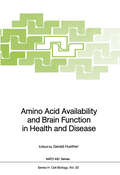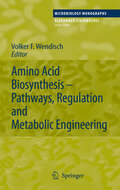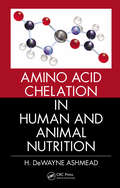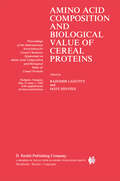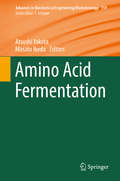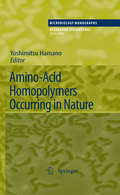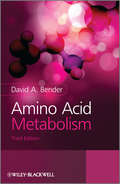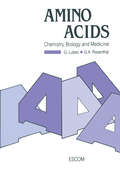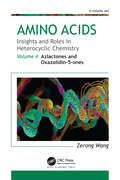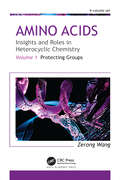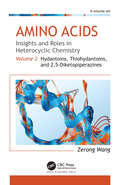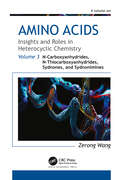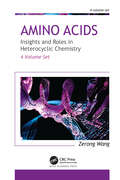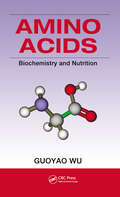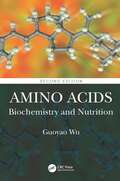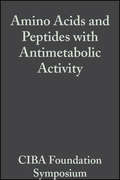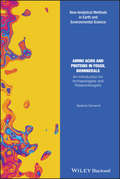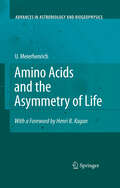- Table View
- List View
Amino Acid Availability and Brain Function in Health and Disease (Nato ASI Subseries H: #20)
by Gerald HuetherThe picture on the following page is being reproduced here, at the request of the partici pants in the Advanced Research Workshop "Amino Acid Availability and Brain Function in Health and Disease". I displayed this limewood carving, entitled "Neurochemistry", during my closing remarks to this extraordinarily stimulating and productive workshop so ably organized by my collaborator Dr. Gerald Huether. We scientists need two sturdy legs to carry us through all the twists and turns of our academic careers. We should also have, as it were, a reserve leg handy, to help us stay upright when this career ends. My "third leg" is wood carving. The idea for "Neurochemis try" came to me in the plane carrying me to the congress of the International Neuro chemical Society in Jerusalem. We need the hands for our meticulous experimental work, and at least one ear to listen to the messages our neurons send us. A few years ago it would have been premature to hold a workshop on this subject. Now, however, the time was just right to allow an overview of the status of current re search, and to point out the promising new openings it has created. There is no doubt that the book to be published as a result of this workshop will be, for the next years at least, the standard text on the subject. Hearty thanks to all speakers for their brilliant con tributions and to all participants for the lively, uninhibited and stimulating discussion.
Amino Acid Biosynthesis – Pathways, Regulation and Metabolic Engineering (Microbiology Monographs #5)
by Volker F. WendischThis book presents the current knowledge of fundamental as well as applied microbiology of amino acids. Coverage details the amino acid biosynthetic pathways, their genetic and biochemical regulation, transport of amino acids and genomics of producing microorganisms. The book also examines the metabolic engineering of microorganisms for the biotechnological production of amino acids for use as pharmaceuticals and as food and feed additives.
Amino Acid Chelation in Human and Animal Nutrition
by H. DeWayne AshmeadAlthough introduction of amino acid chelates in mineral nutrition initially met considerable skepticism and controversy, the greater absorption and bioavailability of amino acid chelated minerals compared to nonchelated minerals have been well-documented for decades. Amino Acid Chelation in Human and Animal Nutrition compiles published chemical, nu
Amino Acid Composition and Biological Value of Cereal Proteins: Proceedings of the International Association for Cereal Chemistry Symposium on Amino Acid Composition and Biological Value of Cereal Proteins
by Radomir Lásztity Máté HidvegiCereals belong to the most important elements in the history of mankind. From the beginning of agriculture, cereals have been by far the most important staple food in the world. Although the cereal consumption decreased to a low level in the developed countries in Europe and North America, in the devel oping countries over two-thirds of the calorie and protein intake is based on cereals. A substantial quantity of cereals goes indirectly into food via feed to animals. Generally, cereal proteins are classified as proteins of lower biological value because of shortage in lysine and some other essential amino acids. Recent developments in the de termination and evaluation of the biological value of proteins and protein mixtures suggest that the oversimplified earlier evaluation of cereal proteins must be reviewed. This book contains the edited proceedings of the Inter national Symposium on "Amino Acid Composition and Biological Value of Cereal Proteins", held in Budapest, Hungary, Hay 31- June 1, 1983, under the sponsorship of the International Association for Cereal Chemistry, Hungarian Scientific Society for Food Industry and Grain Trust, Hungary, with supplemental invited contributions. Scientists (biologist, plant breeders, farmers, chemists, biochemists, engineers, food technologists and nutritionists) from 17 countries presented and reviewed, along with partici pants from 20 countries, the recent methodology and trends in the determination of the biological value of cereal proteins, v the amino acid composition of cereal proteins and factors in fluencing the composition and the role of cereal proteins in nutrition and animal feeding.
Amino Acid Fermentation (Advances in Biochemical Engineering/Biotechnology #159)
by Atsushi Yokota Masato IkedaThis book presents the latest findings on amino acid fermentation and reviews the 50-year history of their development. The book is divided into four parts, the first of which presents a review of amino acid fermentation, past and present. The second part highlights selected examples of amino acid fermentation in more detail, while the third focuses on recent advanced technologies. The last part introduces readers to several topics for future research directions in amino acid production systems. A new field, “amino acid fermentation”, was created by the progress of academic research and industrial development. In 1908, the Japanese researcher Kikunae Ikeda discovered glutamate as an Umami substance. Then a new seasoning, MSG (monosodium glutamate), was commercialized. Although glutamate was extracted from the hydro-lysate of wheat or soybean in the early days, a new production method was subsequently invented – “fermentation” – in which glutamate is produced from sugars such as glucose by a certain bacterium called Corynebacterium. The topic of this volume is particularly connected in a significant way with biochemical, biotechnological, and microbial fields. Both professionals in industry and an academic audience will understand the importance of this volume.
Amino-Acid Homopolymers Occurring in Nature (Microbiology Monographs #15)
by Yoshimitsu HamanoMicroorganisms are capable of producing a wide variety of biopolymers. Homopolymer peptides, which are made up of only a single type of amino acid, are far less ubiquitous. The only two amino-acid homopolymers known to occur in nature are presented in this volume. Poly-epsilon-L-lysine is a polycationic peptide and exhibits antimicrobial activity against a wide spectrum of microorganisms. It is both safe and biodegradable and is therefore used as a food preservative in several countries. In addition, there has been great interest in medical and other applications of poly-lysine and its derivatives. In contrast, poly-gamma-glutamic acid is an unusual anionic polypeptide. It is also water soluble, biodegradable, edible, non-toxic and non-immunogenic and can be chemically modified to introduce various drugs. These features are very useful for pharmaceutical and biomedical applications. Poly-glutamic acid is also a highly attractive as a food ingredient.
Amino Acid Metabolism
by David A. BenderAmino Acid Metabolism, 3rd Edition covers all aspects of the biochemistry and nutritional biochemistry of the amino acids. Starting with an overview of nitrogen fixation and the incorporation of inorganic nitrogen into amino acids, the book then details other major nitrogenous compounds in micro-organisms, plants and animals. Contents include a discussion of the catabolism of amino acids and other nitrogenous compounds in animals, and the microbiological reactions involved in release of nitrogen gas back into the atmosphere. Mammalian (mainly human) protein and amino acid requirements are considered in detail, and the methods that are used to determine them. Chapters consider individual amino acids, grouped according to their metabolic origin, and discussing their biosynthesis (in plants and micro-organisms for those that are dietary essentials for human beings), major metabolic roles (mainly in human metabolism) and catabolism (again mainly in human metabolism). There is also discussion of regulatory mechanisms for all these metabolic pathways, and of metabolic and genetic diseases affecting the (human) metabolism of amino acids. Throughout the book the emphasis is on the nutritional importance of amino acids, integration and control of metabolism and metabolic and other disturbances of relevance to human biochemistry and health. Completely revised edition of this comprehensive text covering all the latest findings in amino acid metabolism research Written by an authority in the field Covers new advances in structural biology Clear illustrations of all structures and metabolic pathways Full list of recommended further reading for each chapter and bibliography of papers cited in the text
Amino Acid Metabolism
by David A. BenderAmino Acid Metabolism, 3rd Edition covers all aspects of the biochemistry and nutritional biochemistry of the amino acids. Starting with an overview of nitrogen fixation and the incorporation of inorganic nitrogen into amino acids, the book then details other major nitrogenous compounds in micro-organisms, plants and animals. Contents include a discussion of the catabolism of amino acids and other nitrogenous compounds in animals, and the microbiological reactions involved in release of nitrogen gas back into the atmosphere. Mammalian (mainly human) protein and amino acid requirements are considered in detail, and the methods that are used to determine them. Chapters consider individual amino acids, grouped according to their metabolic origin, and discussing their biosynthesis (in plants and micro-organisms for those that are dietary essentials for human beings), major metabolic roles (mainly in human metabolism) and catabolism (again mainly in human metabolism). There is also discussion of regulatory mechanisms for all these metabolic pathways, and of metabolic and genetic diseases affecting the (human) metabolism of amino acids. Throughout the book the emphasis is on the nutritional importance of amino acids, integration and control of metabolism and metabolic and other disturbances of relevance to human biochemistry and health. Completely revised edition of this comprehensive text covering all the latest findings in amino acid metabolism research Written by an authority in the field Covers new advances in structural biology Clear illustrations of all structures and metabolic pathways Full list of recommended further reading for each chapter and bibliography of papers cited in the text
Amino Acids: Chemistry, Biology and Medicine
by G. Lubec Gerald A. RosenthalThere is little wonder in the fact that the investigation of amino acids is of fundamental interest to scientists from so many diversified fields. If amino acids were only basic constituents of enzymes as well as structural and other proteins, this property alone would elevate them to real scientific importance. Added to this role, however, is their ability to serve as building blocks for the production of many classes of secondary metabolites. They can support the biosynthesis of a myriad of natural products including nonprotein amino acids, cyanogenic glycosides, phar macologically active alkaloids, certain phenols, purines and pyrimidines, nucleic acids, condensed tannins, lignins and other metabolites. The approximately twenty or so amino (and imino) acids that comprise proteins are well known; less familiar are what is now approaching 600 nonprotein amino acids that have been isolated and characterized from plant, fungal or animal sources. Investigations of the protein amino acids have proven of outstanding value in enhancing our understanding of a variety of physiological and neurological topics that affect human health and well being. Amino acids are used to probe inhibitory and excitatory transmission receptors in the brain. They contribute to our understanding of epilepsy, development of anti-epileptic drugs, production of novel y-arninobutyric acid uptake inhibitors, and acute and chronic neurodegenera tive disorders.
Amino Acids: Volume 4: Azlactones and Oxazolidin-5-ones
by Zerong WangThis first-of-its-kind four-volume book series provides up-to-date information on α-amino acids, detailing the potential challenges in working with α-amino acids, the protecting groups for the carboxyl, side chain groups of the amino acids, and the most popular heterocyclic compounds that are originating from α-amino acids. These heterocyclic compounds include hydantoins, thiohydantoins (including 2-thiohydantoins, 4-thiohydantoins, 2,4-dithiohydantoins), 2,5-diketopiperazines, N-carboxyanhydrides, N-thiocarboxyanhydrides, sydnones, sydnonimines, azlactones, pseudoazlactones, and oxazolidin-5-ones. This is the first resource to comprehensively present all the heterocycles that can be directly prepared from α-amino acids. In addition, almost all kinds of synthetic methods for a particular type of heterocycles from α-amino acids are included, along with the detailed mechanistic discussions and experimental procedures. Volume 4: Azlactones and Oxazolidin-5-ones discusses two types of simple heterocycles that can be prepared from α-amino acids, i.e., azlactones (also known as oxazolones, 4-unsaturated azlactones included) and oxazolidin-5-ones. These heterocyclic compounds behave differently in both biological and chemical properties, and their biological activities are presented in a well-organized manner in this volume. The other volumes in the set are: Volume 1: Protecting Groups Volume 2: Hydantoins, Thiohydantoins, and 2,5-Diketopiperazines Volume 3: N-Carboxyanhydrides, N-Thiocarboxyanhydrides, and Sydnones All together, this unique 4-volume set thoroughly covers the two types of heterocyclic compounds that are originated from alpha-amino acids, providing carefully compiled updated information with detailed examples. The author has shared many thoughtful insights based on his strong background in physical organic chemistry. The volumes will be highly valuable for graduate students and senior students, as well as for professors and researchers working in the field of medicinal and pharmaceutical chemistry, organic chemistry, organic synthesis, heterocycles, and proteins and peptides.
Amino Acids: Volume 1: Protecting Groups
by Zerong WangThis is the first volume of a first-of-its-kind four-volume book set that provides readers with up-to-date information on α-amino acids, the potential challenges in working with α-amino acids, the protecting groups for the carboxyl, amino and side chain groups of the amino acids, and the most popular heterocyclic compounds that are originating from α-amino acids. These heterocyclic compounds include hydantoins, thiohydantoins (including 2-thiohydantoins, 4-thiohydantoins, 2,4-dithiohydantoins), 2,5-diketopiperazines, N-carboxyanhydrides, N-thiocarboxyanhydrides, sydnones, sydnonimines, azlactones, pseudoazlactones, and oxazolidin-5-ones. This is the first resource to comprehensively collect all the heterocycles that can be directly prepared from α-amino acids. In addition, almost all kinds of synthetic methods for a particular type of heterocycles from α-amino acids are included, along with the detailed mechanistic discussions and experimental procedures. Volume 1: Protecting Groups collects and discusses the 260 protecting groups relating to amino acids, which have been organized by carboxyl group, amino group, and side chain group. The conditions to introduce these protecting groups as well as their deprotecting procedures have also been incorporated, along with the physical properties, solvent effects, and temperature effects on the solubility of amino acids. It presents the solubility of glycine and phenylalanine in a variety of solvent systems to show the impact on amino acid, where glycine generally represents the polar amino acid whereas phenylalanine represents the amino acid of non-polar side chain. The other volumes include: Volume 2: Hydantoins, Thiohydantoins, and 2,5-Diketopiperazines Volume 3: N-Carboxyanhydrides, N-Thiocarboxyanhydrides, and Sydnones Volume 4: Azlactones and Oxazolidin-5-ones All together, this unique 4-volume set thoroughly covers the two types of heterocyclic compounds that are originated from alpha-amino acids, providing carefully compiled updated information with detailed examples. The author has shared many thoughtful insights based on his strong background in physical organic chemistry. The volumes will be highly valuable for graduate students and senior students, as well as for professors and researchers working in the field of medicinal and pharmaceutical chemistry, organic chemistry, organic synthesis, heterocycles, and proteins and peptides.
Amino Acids: Volume 2: Hydantoins, Thiohydantoins, and 2,5-Diketopiperazines
by Zerong WangThis is the second volume of a first-of-its-kind four-volume book set that provides readers with up-to-date information on α-amino acids, the potential challenges in working with α-amino acids, the protecting groups for the carboxyl, amino and side chain groups of the amino acids, and the most popular heterocyclic compounds that are originating from alpha-amino acids. These heterocyclic compounds include hydantoins, thiohydantoins (including 2-thiohydantoins, 4-thiohydantoins, 2,4-dithiohydantoins), 2,5-diketopiperazines, N-carboxyanhydrides, N-thiocarboxyanhydrides, sydnones, sydnonimines, azlactones, pseudoazlactones, and oxazolidin-5-ones. This is the first resource to comprehensively collect all the heterocycles that can be directly prepared from α-amino acids. In addition, almost all kinds of synthetic methods for a particular type of heterocycles from alpha-amino acids are included, along with the detailed mechanistic discussions and experimental procedures. In Volume 2: Hydantoins, Thiohydantoins, and 2,5-Diketopiperazines compiles the three IUPAC accepted nomenclature systems for heterocyclic compounds, which will be very useful for readers working in the heterocyclic chemistry field for giving synthesized molecules their correct names. In addition, three groups of heterocyclic compounds, i.e., hydantoins, thiohydantoins (including 2-thiohydantoin, 4-thiohydantoin and 2,4-dithiohydantoin), and 2,5-diketopiperazines, have been organized with updated literature information. Particularly, all three groups of heterocyclic compounds have demonstrated many important biological activities, particularly anticancer and antibacterial activities. On the other hand, these three groups of heterocycles can be applied as substrates to make other chemical derivatives, particularly novel unnatural amino acids. All their reactivities have been compiled and updated. The other volumes include: Volume 1: Protecting Groups Volume 3: N-Carboxyanhydrides, N-Thiocarboxyanhydrides, and Sydnones Volume 4: Azlactones and Oxazolidin-5-ones All together, this unique 4-volume set thoroughly covers the two types of heterocyclic compounds that are originated from alpha-amino acids, providing carefully compiled updated information with detailed examples. The author has shared many thoughtful insights based on his strong background in physical organic chemistry. The volumes will be highly valuable for graduate students and senior students, as well as for professors and researchers working in the field of medicinal and pharmaceutical chemistry, organic chemistry, organic synthesis, heterocycles, and proteins and peptides.
Amino Acids: Volume 3: N-Carboxyanhydrides, N-Thiocarboxyanhydrides, Sydnones, and Sydnonimines
by Zerong WangThis is the third volume of a first-of-its-kind four-volume book set that provides readers with up-to-date information on α-amino acids, the potential challenges in working with α-amino acids, the protecting groups for the carboxyl, amino and side chain groups of the amino acids, and the most popular heterocyclic compounds that are originating from α-amino acids. These heterocyclic compounds include hydantoins, thiohydantoins (including 2-thiohydantoins, 4-thiohydantoins, 2,4-dithiohydantoins), 2,5-diketopiperazines, N-carboxyanhydrides, N-thiocarboxyanhydrides, sydnones, sydnonimines, azlactones, pseudoazlactones, and oxazolidin-5-ones. This is the first resource to comprehensively collect all the heterocycles that can be directly prepared from α-amino acids. In addition, almost all kinds of synthetic methods for a particular type of heterocycles from α-amino acids are included, along with the detailed mechanistic discussions and experimental procedures. Volume 3: N-Carboxyanhydrides, N-Thiocarboxyanhydrides, and Sydnones presents up-to-date detailed information on two types of heterocyclic compounds that originate from alpha-amino acids: NCAs/NTAs and sydnones/sydnonimines. The volume also covers the more than 10 initiating systems for NCA monomers to undergo the ring-opening polymerization, which are very useful for the readers in order to make living polypeptides/polypeptoids. In addition, the method to characterize these prepared polypeptides/polypeptoids is also included. Particularly, two modern mass spectrometric techniques (MALDI-TOF and ESI-TOF) have been explained with detailed examples, where the elucidation of molecular weight of protein based on the ESI-TOF spectra has been given with a practical example as well as the theory that it is based on, a unique feature of the volume. The other volumes in the set are: Volume 1: Protecting Groups Volume 2: Hydantoins, Thiohydantoins, and 2,5-Diketopiperazines Volume 4: Azlactones and Oxazolidin-5-ones All together, this unique 4-volume set thoroughly covers the two types of heterocyclic compounds that are originated from alpha-amino acids, providing carefully compiled updated information with detailed examples. The author has shared many thoughtful insights based on his strong background in physical organic chemistry. The volumes will be highly valuable for graduate students and senior students, as well as for professors and researchers working in the field of medicinal and pharmaceutical chemistry, organic chemistry, organic synthesis, heterocycles, and proteins and peptides.
Amino Acids: Volume 2: Hydantoins, Thiohydantoins, and 2,5-Diketopiperazines
by Zerong WangThis is the second volume of a first-of-its-kind four-volume book set that provides readers with up-to-date information on α-amino acids, the potential challenges in working with α-amino acids, the protecting groups for the carboxyl, amino and side chain groups of the amino acids, and the most popular heterocyclic compounds that are originating from alpha-amino acids. These heterocyclic compounds include hydantoins, thiohydantoins (including 2-thiohydantoins, 4-thiohydantoins, 2,4-dithiohydantoins), 2,5-diketopiperazines, N-carboxyanhydrides, N-thiocarboxyanhydrides, sydnones, sydnonimines, azlactones, pseudoazlactones, and oxazolidin-5-ones. This is the first resource to comprehensively collect all the heterocycles that can be directly prepared from α-amino acids. In addition, almost all kinds of synthetic methods for a particular type of heterocycles from alpha-amino acids are included, along with the detailed mechanistic discussions and experimental procedures. In Volume 2: Hydantoins, Thiohydantoins, and 2,5-Diketopiperazines compiles the three IUPAC accepted nomenclature systems for heterocyclic compounds, which will be very useful for readers working in the heterocyclic chemistry field for giving synthesized molecules their correct names. In addition, three groups of heterocyclic compounds, i.e., hydantoins, thiohydantoins (including 2-thiohydantoin, 4-thiohydantoin and 2,4-dithiohydantoin), and 2,5-diketopiperazines, have been organized with updated literature information. Particularly, all three groups of heterocyclic compounds have demonstrated many important biological activities, particularly anticancer and antibacterial activities. On the other hand, these three groups of heterocycles can be applied as substrates to make other chemical derivatives, particularly novel unnatural amino acids. All their reactivities have been compiled and updated. The other volumes include: Volume 1: Protecting Groups Volume 3: N-Carboxyanhydrides, N-Thiocarboxyanhydrides, and Sydnones Volume 4: Azlactones and Oxazolidin-5-ones All together, this unique 4-volume set thoroughly covers the two types of heterocyclic compounds that are originated from alpha-amino acids, providing carefully compiled updated information with detailed examples. The author has shared many thoughtful insights based on his strong background in physical organic chemistry. The volumes will be highly valuable for graduate students and senior students, as well as for professors and researchers working in the field of medicinal and pharmaceutical chemistry, organic chemistry, organic synthesis, heterocycles, and proteins and peptides.
Amino Acids: Volume 4: Azlactones and Oxazolidin-5-ones
by Zerong WangThis first-of-its-kind four-volume book series provides up-to-date information on α-amino acids, detailing the potential challenges in working with α-amino acids, the protecting groups for the carboxyl, side chain groups of the amino acids, and the most popular heterocyclic compounds that are originating from α-amino acids. These heterocyclic compounds include hydantoins, thiohydantoins (including 2-thiohydantoins, 4-thiohydantoins, 2,4-dithiohydantoins), 2,5-diketopiperazines, N-carboxyanhydrides, N-thiocarboxyanhydrides, sydnones, sydnonimines, azlactones, pseudoazlactones, and oxazolidin-5-ones. This is the first resource to comprehensively present all the heterocycles that can be directly prepared from α-amino acids. In addition, almost all kinds of synthetic methods for a particular type of heterocycles from α-amino acids are included, along with the detailed mechanistic discussions and experimental procedures. Volume 4: Azlactones and Oxazolidin-5-ones discusses two types of simple heterocycles that can be prepared from α-amino acids, i.e., azlactones (also known as oxazolones, 4-unsaturated azlactones included) and oxazolidin-5-ones. These heterocyclic compounds behave differently in both biological and chemical properties, and their biological activities are presented in a well-organized manner in this volume. The other volumes in the set are: Volume 1: Protecting Groups Volume 2: Hydantoins, Thiohydantoins, and 2,5-Diketopiperazines Volume 3: N-Carboxyanhydrides, N-Thiocarboxyanhydrides, and Sydnones All together, this unique 4-volume set thoroughly covers the two types of heterocyclic compounds that are originated from alpha-amino acids, providing carefully compiled updated information with detailed examples. The author has shared many thoughtful insights based on his strong background in physical organic chemistry. The volumes will be highly valuable for graduate students and senior students, as well as for professors and researchers working in the field of medicinal and pharmaceutical chemistry, organic chemistry, organic synthesis, heterocycles, and proteins and peptides.
Amino Acids: Volume 3: N-Carboxyanhydrides, N-Thiocarboxyanhydrides, Sydnones, and Sydnonimines
by Zerong WangThis is the third volume of a first-of-its-kind four-volume book set that provides readers with up-to-date information on α-amino acids, the potential challenges in working with α-amino acids, the protecting groups for the carboxyl, amino and side chain groups of the amino acids, and the most popular heterocyclic compounds that are originating from α-amino acids. These heterocyclic compounds include hydantoins, thiohydantoins (including 2-thiohydantoins, 4-thiohydantoins, 2,4-dithiohydantoins), 2,5-diketopiperazines, N-carboxyanhydrides, N-thiocarboxyanhydrides, sydnones, sydnonimines, azlactones, pseudoazlactones, and oxazolidin-5-ones. This is the first resource to comprehensively collect all the heterocycles that can be directly prepared from α-amino acids. In addition, almost all kinds of synthetic methods for a particular type of heterocycles from α-amino acids are included, along with the detailed mechanistic discussions and experimental procedures. Volume 3: N-Carboxyanhydrides, N-Thiocarboxyanhydrides, and Sydnones presents up-to-date detailed information on two types of heterocyclic compounds that originate from alpha-amino acids: NCAs/NTAs and sydnones/sydnonimines. The volume also covers the more than 10 initiating systems for NCA monomers to undergo the ring-opening polymerization, which are very useful for the readers in order to make living polypeptides/polypeptoids. In addition, the method to characterize these prepared polypeptides/polypeptoids is also included. Particularly, two modern mass spectrometric techniques (MALDI-TOF and ESI-TOF) have been explained with detailed examples, where the elucidation of molecular weight of protein based on the ESI-TOF spectra has been given with a practical example as well as the theory that it is based on, a unique feature of the volume. The other volumes in the set are: Volume 1: Protecting Groups Volume 2: Hydantoins, Thiohydantoins, and 2,5-Diketopiperazines Volume 4: Azlactones and Oxazolidin-5-ones All together, this unique 4-volume set thoroughly covers the two types of heterocyclic compounds that are originated from alpha-amino acids, providing carefully compiled updated information with detailed examples. The author has shared many thoughtful insights based on his strong background in physical organic chemistry. The volumes will be highly valuable for graduate students and senior students, as well as for professors and researchers working in the field of medicinal and pharmaceutical chemistry, organic chemistry, organic synthesis, heterocycles, and proteins and peptides.
Amino Acids: Volume 1: Protecting Groups
by Zerong WangThis is the first volume of a first-of-its-kind four-volume book set that provides readers with up-to-date information on α-amino acids, the potential challenges in working with α-amino acids, the protecting groups for the carboxyl, amino and side chain groups of the amino acids, and the most popular heterocyclic compounds that are originating from α-amino acids. These heterocyclic compounds include hydantoins, thiohydantoins (including 2-thiohydantoins, 4-thiohydantoins, 2,4-dithiohydantoins), 2,5-diketopiperazines, N-carboxyanhydrides, N-thiocarboxyanhydrides, sydnones, sydnonimines, azlactones, pseudoazlactones, and oxazolidin-5-ones. This is the first resource to comprehensively collect all the heterocycles that can be directly prepared from α-amino acids. In addition, almost all kinds of synthetic methods for a particular type of heterocycles from α-amino acids are included, along with the detailed mechanistic discussions and experimental procedures. Volume 1: Protecting Groups collects and discusses the 260 protecting groups relating to amino acids, which have been organized by carboxyl group, amino group, and side chain group. The conditions to introduce these protecting groups as well as their deprotecting procedures have also been incorporated, along with the physical properties, solvent effects, and temperature effects on the solubility of amino acids. It presents the solubility of glycine and phenylalanine in a variety of solvent systems to show the impact on amino acid, where glycine generally represents the polar amino acid whereas phenylalanine represents the amino acid of non-polar side chain. The other volumes include: Volume 2: Hydantoins, Thiohydantoins, and 2,5-Diketopiperazines Volume 3: N-Carboxyanhydrides, N-Thiocarboxyanhydrides, and Sydnones Volume 4: Azlactones and Oxazolidin-5-ones All together, this unique 4-volume set thoroughly covers the two types of heterocyclic compounds that are originated from alpha-amino acids, providing carefully compiled updated information with detailed examples. The author has shared many thoughtful insights based on his strong background in physical organic chemistry. The volumes will be highly valuable for graduate students and senior students, as well as for professors and researchers working in the field of medicinal and pharmaceutical chemistry, organic chemistry, organic synthesis, heterocycles, and proteins and peptides.
Amino Acids: 4-volume set (Routledge Studies In Contemporary Philosophy Ser.)
by Zerong WangThis first-of-its-kind four-volume book series, Amino Acids: Insights and Roles in Heterocyclic Chemistry, provides readers with up-to-date information on alpha-amino acids, the potential challenges in working with alpha-amino acids, the protecting groups for the carboxyl, amino and side chain groups of the amino acids, and the most popular heterocyclic compounds that are originating from alpha-amino acids. These heterocyclic compounds include hydantoins, thiohydantoins (including 2-thiohydantoins, 4-thiohydantoins, 2,4-dithiohydantoins), 2,5-diketopiperazines, N-carboxyanhydrides, N-thiocarboxyanhydrides, sydnones, sydnonimines, azlactones, pseudoazlactones, and oxazolidin-5-ones. This is the first resource to comprehensively collect all the heterocycles that can be directly prepared from alpha-amino acids. In addition, almost all kinds of synthetic methods for a particular type of heterocycles from alpha-amino acids are included, along with the detailed mechanistic discussions and experimental procedures. Volume 1: Protecting Groups collects and discusses the 260 protecting groups relating to amino acids, which have been organized by carboxyl group, amino group, and side chain groups. The conditions to introduce these protecting groups as well as their deprotecting procedures have also been incorporated, along with the physical properties, solvent effects, and temperature effects on the solubility of amino acids. It presents the solubility of glycine and phenylalanine in a variety of solvent systems to show the impact on amino acid, where glycine generally represents the polar amino acid whereas phenylalanine represents the amino acid of non-polar side chain. In Volume 2: Hydantoins, Thiohydantoins, and 2,5-Diketopiperazines, the author has compiled the three IUPAC accepted nomenclature systems for heterocyclic compounds, which will be very useful for readers working in the heterocyclic chemistry field for giving the synthesized molecules their correct names. In addition, three groups of heterocyclic compounds, i.e., hydantoins, thiohydantoins (including 2-thiohydantoin, 4-thiohydantoin and 2,4-dithiohydantoin), and 2,5-diketopiperazines, have been organized with updated literature information. Particularly, all three groups of heterocyclic compounds have demonstrated many important biological activities, particularly anticancer and antibacterial activities. On the other hand, these three groups of heterocycles can be applied as substrates to make other chemical derivatives, particularly novel unnatural amino acids. All their reactivities have been compiled and updated. These will be very valuable for readers who have been working in this area or have interest in this area. Volume 3: N-Carboxyanhydrides, N-Thiocarboxyanhydrides, and Sydnones presents up-to-date detailed information on two types of heterocyclic compounds that are originated from alpha-amino acids: NCAs/NTAs and sydnones/sydnonimines. The volume also covers the more than 10 initiating systems for the NCA monomers to undergo the ring-opening polymerization, which are very useful for readers in order to make living polypeptides/polypeptoids. In addition, the method to characterize these prepared polypeptides/polypeptoids are included. Particularly, two modern mass spectrometric techniques (MALDI-TOF and ESI-TOF) have been explained with detailed examples, where the elucidation of molecular weight of protein based on the ESI-TOF spectra have been given with a practical example as well as the theory that is based on, a unique feature of the volume. Volume 4: Azlactones and Oxazolidin-5-ones discusses two types of simple heterocycles that can be prepared from alpha-amino acids, i.e., azlactones (also known as oxazolones, 4-unsaturated azlactones included) and oxazolidin-5-ones. These heterocyclic compounds behave differently in both biological and chemical properties, and their biological activities are presented in a well-organized manner in this volume. This unique 4-volume set th
Amino Acids: Biochemistry and Nutrition
by Guoyao WuAmino acid biochemistry and nutrition spans a broad range of fields including biochemistry, metabolism, physiology, immunology, reproduction, pathology, and cell biology. In the last half-century, there have been many conceptual and technical advancements, from analysis of amino acids by high-performance liquid chromatography and mass spectrometry
Amino Acids: Biochemistry and Nutrition
by Guoyao WuFollowing its predecessor, the second edition of Amino Acids: Biochemistry and Nutrition presents exhaustive coverage of amino acids in the nutrition, metabolism and health of humans and other animals. Substantially revised, expanded and updated to reflect scientific advances, this book introduces the basic principles of amino acid biochemistry and nutrition, while highlighting the current knowledge of the field and its future possibilities. The book begins with the basic chemical concepts of amnio acids, peptides and proteins, and their digestion and absorption. Subsequent chapters cover cell-, tissue-, and species-specific synthesis and catabolism of amino acids and related bioactive metabolites, and the use of isotopes to study amino acids metabolism in cells and the body. The book details protein turnover, physiological functions of amino acids, as well as both the regulation and inborn errors of amino acid metabolism. The book concludes with a presentation on human and animal dietary requirements of amino acids and evaluates dietary protein quality. Features: Encompasses a comprehensive coverage of basic to applied concepts in amino acid metabolism in humans and other animals. Highlights important roles of dietary amino acids and protein intake in growth, physical performance and health, including sarcopenia mitigation and immunity. Discusses concerns over the excess intakes of amino acids or protein in the development of diseases, including cardiovascular disorders, diabetes and cancers, as well as bone integrity Each chapter contains select references to provide comprehensive reviews and original experimental data on the topics discussed. Each chapter is backed by original experimental data on various topics discussed and contains select references to aid the reader further in research. Written by Distinguished Professor of Animal Nutrition, Guoyao Wu, Ph.D., this book is an authoritative reference for students and researchers in both biomedicine and agriculture.
Amino Acids: Biochemistry and Nutrition
by Guoyao WuFollowing its predecessor, the second edition of Amino Acids: Biochemistry and Nutrition presents exhaustive coverage of amino acids in the nutrition, metabolism and health of humans and other animals. Substantially revised, expanded and updated to reflect scientific advances, this book introduces the basic principles of amino acid biochemistry and nutrition, while highlighting the current knowledge of the field and its future possibilities. The book begins with the basic chemical concepts of amnio acids, peptides and proteins, and their digestion and absorption. Subsequent chapters cover cell-, tissue-, and species-specific synthesis and catabolism of amino acids and related bioactive metabolites, and the use of isotopes to study amino acids metabolism in cells and the body. The book details protein turnover, physiological functions of amino acids, as well as both the regulation and inborn errors of amino acid metabolism. The book concludes with a presentation on human and animal dietary requirements of amino acids and evaluates dietary protein quality. Features: Encompasses a comprehensive coverage of basic to applied concepts in amino acid metabolism in humans and other animals. Highlights important roles of dietary amino acids and protein intake in growth, physical performance and health, including sarcopenia mitigation and immunity. Discusses concerns over the excess intakes of amino acids or protein in the development of diseases, including cardiovascular disorders, diabetes and cancers, as well as bone integrity Each chapter contains select references to provide comprehensive reviews and original experimental data on the topics discussed. Each chapter is backed by original experimental data on various topics discussed and contains select references to aid the reader further in research. Written by Distinguished Professor of Animal Nutrition, Guoyao Wu, Ph.D., this book is an authoritative reference for students and researchers in both biomedicine and agriculture.
Amino Acids and Peptides with Antimetabolic Activity (Novartis Foundation Symposia #898)
by G. E. W. Wolstenholme Cecilia M. O'ConnorThe Novartis Foundation Series is a popular collection of the proceedings from Novartis Foundation Symposia, in which groups of leading scientists from a range of topics across biology, chemistry and medicine assembled to present papers and discuss results. The Novartis Foundation, originally known as the Ciba Foundation, is well known to scientists and clinicians around the world.
Amino Acids and Proteins in Fossil Biominerals: An Introduction for Archaeologists and Palaeontologists (Analytical Methods in Earth and Environmental Science)
by Beatrice DemarchiAMINO ACIDS AND PROTEINS IN FOSSIL BIOMINERALS An essential cross-disciplinary guide to the proteins that form biominerals and that are preserved in the fossil record?? Amino Acids and Proteins in Fossil Biominerals is an authoritative guide to the patterns of survival and degradation of ancient biomolecules in the fossil record. The author brings together new research in biomineralization and ancient proteins to describe mechanisms of protein diagenesis. The book draws on the author's experiences as well as current information from three research fields: geochemistry, archaeology and Quaternary sciences. The author examines the history of the study of ancient proteins, from the dating of Quaternary biominerals to the present advances in shotgun proteomics, and discusses their applications across archaeology, geology and evolutionary biology. This important guide:?? Explores the main components of biominerals Describes the breakdown of proteins in fossils Reviews the applications of ancient protein studies Written for students and researchers of biomolecular archaeology and palaeontology, Amino Acids and Proteins in Fossil Biominerals provides a cross-disciplinary guide to the proteins responsible for the formation of biominerals and to the survival of biomolecules in the archaeological and palaeontological record. This book forms one volume of the popular New Analytical Methods in Earth and Environmental Science Series.
Amino Acids and Proteins in Fossil Biominerals: An Introduction for Archaeologists and Palaeontologists (Analytical Methods in Earth and Environmental Science)
by Beatrice DemarchiAMINO ACIDS AND PROTEINS IN FOSSIL BIOMINERALS An essential cross-disciplinary guide to the proteins that form biominerals and that are preserved in the fossil record?? Amino Acids and Proteins in Fossil Biominerals is an authoritative guide to the patterns of survival and degradation of ancient biomolecules in the fossil record. The author brings together new research in biomineralization and ancient proteins to describe mechanisms of protein diagenesis. The book draws on the author's experiences as well as current information from three research fields: geochemistry, archaeology and Quaternary sciences. The author examines the history of the study of ancient proteins, from the dating of Quaternary biominerals to the present advances in shotgun proteomics, and discusses their applications across archaeology, geology and evolutionary biology. This important guide:?? Explores the main components of biominerals Describes the breakdown of proteins in fossils Reviews the applications of ancient protein studies Written for students and researchers of biomolecular archaeology and palaeontology, Amino Acids and Proteins in Fossil Biominerals provides a cross-disciplinary guide to the proteins responsible for the formation of biominerals and to the survival of biomolecules in the archaeological and palaeontological record. This book forms one volume of the popular New Analytical Methods in Earth and Environmental Science Series.
Amino Acids and the Asymmetry of Life: Caught in the Act of Formation (Advances in Astrobiology and Biogeophysics)
by Uwe Meierhenrich"How did life originate and why were left-handed molecules selected for its architecture?" This question of high public and interdisciplinary scientific interest is the central theme of this book. It is widely known that in processes triggering the origin of life on Earth, the equal occurrence, the parity between left-handed amino acids and their right-handed mirror images, was violated. The balance was inevitably tipped to the left – as a result of which life's proteins today exclusively implement the left form of amino acids. Written in an engaging style, this book describes how the basic building blocks of life, the amino acids, formed. After a comprehensible introduction to stereochemistry, the author addresses the inherent property of amino acids in living organisms, namely the preference for left-handedness. What was the cause for the violation of parity of amino acids in the emergence of life on Earth? All the fascinating models proposed by physicists, chemists and biologist are vividly presented including the scientific conflicts. The author describes the attempt to verify any of those models with the chirality module of the ROSETTA mission, a probe built and launched with the mission to land on a comet and analyse whether there are chiral organic compounds that could have been brought to the Earth by cometary impacts. A truly interdisciplinary astrobiology book, "Amino Acids and the Asymmetry of Life" will fascinate students, researchers and all readers with backgrounds in natural sciences. With a foreword by Henri B. Kagan.
